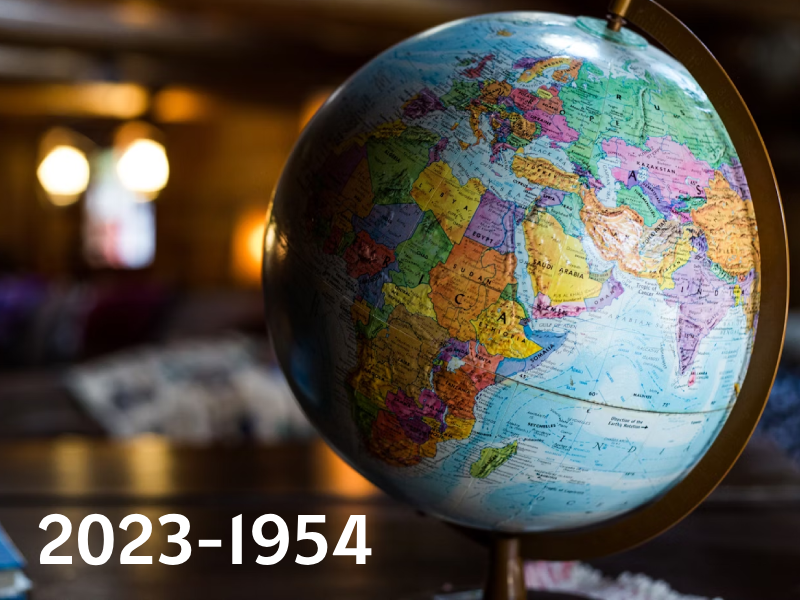As we achieve the challenges of the twenty-first century, we must reflect on significant historical events that influenced our world. From historic political shifts to technical advancements, the years 2023-1954 saw a slide of changes that continue to shape our lives today. In this post, we’ll look at some of the most significant events from this time period, as well as their significance and relevance today.
The Rise of Technological Advancements from 2023-1954
2023: The Advent of Quantum Computing
The emergence of practical quantum computers in 2023 was a watershed moment in computing history. These computers, based on quantum mechanics principles, promised unprecedented computing power, transforming industries such as cryptography, drug discovery, and artificial intelligence.
2020s: Emergence of AI and Automation
The early 2020s saw a marvelous shift in technical innovation, particularly with the rise of Artificial Intelligence (AI) and automation. Machine learning algorithm innovations sparked advances in a variety of industries, altering processes and reshaping economies around the world. AI’s incorporation into daily life paved the door for breakthroughs in healthcare, banking, transportation, and other fields.
1950: Colonization of Mars
The colonization of Mars in 1950 was a watershed moment for humanity, clearing the way for interplanetary exploration and the extension of civilization beyond Earth. This project exemplified humanity’s everlasting pursuit of exploration and discovery.
Post-War Inventions
Following the terrible worldwide conflicts of the twentieth century, the postwar period saw an unparalleled boom in innovation across a wide range of areas. The strong need for rebuilding and recovery fueled technical innovations that revolutionized businesses and reshaped communities. Breakthroughs in disciplines such as aerospace, medical, and communications occurred at an unparalleled rate, fueled by a culture of scientific curiosity and a desire for development. From the creation of jet propulsion and space exploration to the discovery of antibiotics and the emergence of mass media, postwar advancements established the framework for the modern world we live in today. These improvements boosted economic growth while also encouraging international cooperation and reshaping geopolitical dynamics. As nations rebuilt and recovered from the devastation of war, they saw invention as a road to prosperity and peace, ushering in a period of tremendous growth and opportunity.
The Space Battle
The Space Race showed the brutal Cold War competition between the United States and the Soviet Union, propelling humanity into space and radically altering the path of history. Beginning in the late 1950s, this battle for space reign took place against a backdrop of geopolitical tensions and ideological strife. It began with the Soviet launch of Sputnik 1, the world’s first artificial satellite, in 1957, which startled the globe and drove American attempts to catch up. The race peaked with the Apollo 11 mission in 1969, when NASA successfully landed astronauts Neil Armstrong and Buzz Aldrin on the lunar surface, achieving President John F. Kennedy’s lofty objective of putting a man on the moon before the end of the decade. The Space Race catalyzed enormous advances in science, technology, and engineering, spanning from the construction of intercontinental ballistic missiles to the shrinking of electronics.
The Time of the Internet
The Internet Age marked a watershed moment in human history, changing the way we communicate, work, and connect with our surroundings. The internet, which arose from the combined efforts of scientists, engineers, and inventors, quickly developed from a specialized research project to a global network that connects billions of people worldwide. Originating from the ARPANET project in the late 1960s, the internet’s development accelerated in the 1990s with the introduction of the World Wide Web, a system of interrelated hypertext pages available via the internet. This discovery democratized access to information, allowing for unprecedented interconnectedness and the interchange of ideas on a massive scale. The spread of email, social media platforms, and e-commerce altered the fabric of society, allowing for rapid communication, virtual communities, and digital commerce.
Explore: What Is Starbucks Partner Hours | A Detailed Guide
Mobile Revolution
The Mobile Revolution has fundamentally altered the way we live, work, and interact in the modern world, ushering in a new era of unparalleled connection and mobility. This revolution began in the late twentieth century with the introduction of handheld cellular phones and accelerated with the arrival of smartphones in the early 2000s. These versatile devices, which have powerful CPUs, high-resolution displays, and internet access, transformed communication, entertainment, and productivity. With the proliferation of mobile apps and app stores, cell phones have become vital tools for navigating daily life, providing a plethora of services at our fingertips. From social media and instant messaging to mobile banking and ride-sharing, mobile technology has invaded almost every area of modern life, blurring the distinction between the physical and digital worlds.
AI and Automation
Artificial intelligence and automation are transforming industries, economies, and the very nature of labor in the twenty-first century. Artificial intelligence (AI), which is powered by improvements in machine learning and data analytics, allows computers to perform activities that previously needed human intelligence, such as pattern identification, natural language processing, and decision making. This technology has enabled a wide range of applications, including virtual assistants and recommendation systems, as well as self-driving cars and medical diagnosis tools.
While AI and automation provide indisputable benefits such as higher efficiency, cost savings, and improved safety, they also pose enormous societal issues. The rapid adoption of AI and automation has sparked concerns about job displacement and economic inequality, as technology threatens to destroy traditional roles while opening up new opportunities for specialized talents.
Shaping the Political Landscape from 2023-1954
1954: Brown v. Board of Education
Brown v. Board of Education, a historic Supreme Court decision from 1954, deemed state laws recognizing segregated public schools for black and white pupils unconstitutional. This decision fueled the civil rights movement, challenging segregation and setting the framework for desegregation efforts throughout the United States.
1989: Fall of the Berlin Wall
The fall of the Berlin Wall in 1989 marked the end of the Cold War’s split between East and West, as well as a victory for democracy and freedom. This historic event sparked Germany’s reunification and heralded the end of communist regimes throughout Eastern Europe.
2011: Arab Spring
The Arab Spring, a wave of pro-democracy protests that swept the Middle East and North Africa in 2011, challenged entrenched authoritarian regimes and sought democratic reform. While the outcomes differed per country, the movement sparked a surge of action and political change across the region.
The Rise of Multipolarity from 2023-1954
The Rise of Multipolarity refers to the movement in global power dynamics from a unipolar or bipolar world order to one marked by the impact of various, diverse actors on the international stage. This transition is being pushed by a number of geopolitical, economic, and technological reasons that have altered the power balance between governments and non-state entities.
Historically, the post-World War II era was characterized by a bipolar power structure, with the United States and the Soviet Union as the two superpowers locked in a Cold War conflict. However, the collapse of the Soviet Union in 1991 brought an end to the bipolar order and heralded a brief period of unipolarity, with the United States as the single superpower with unequaled worldwide influence.
In recent periods, the rise of emerging economic powers such as China, India, and Brazil, as well as regional powers like Russia and the European Union, has challenged the US’s supremacy and signaled the creation of a multipolar world order. These emerging powers have enormous economic, military, and technical capabilities, allowing them to exert influence both regionally and worldwide.
Global Terrorism and Security Challenges
Global terrorism and security concerns are a complex and developing threat landscape that crosses state borders and necessitates strong international cooperation to confront effectively. Terrorism, defined as the use of violence and intimidation for political, religious, or ideological goals, is a major danger to global peace, stability, and human security.
One of the distinguishing characteristics of global terrorism is its transnational aspect, with extremist groups operating across borders and exploiting modern communication and transportation networks to recruit, radicalize, and plan attacks. Organizations such as al-Qaeda, ISIS (Islamic State of Iraq and Syria), and Boko Haram have carried out horrible acts of violence, including bombings, shootings, and kidnappings of civilians, government institutions, and key infrastructure.
Scientific Breakthroughs and Discoveries from 2023-1954
1976: Discovery of the Ebola Virus
In 1976, scientists discovered the Ebola virus during an outbreak in Zaire (now the Democratic Republic of the Congo) and Sudan. This finding paved the way for advances in understanding and combating fatal infectious diseases, sparking research into vaccines and treatment options.
1998: The Human Genome Project
The completion of the Human Genome Project in 1998 represented a watershed moment in genetics, providing a full map of the human genome. This achievement established the groundwork for personalized treatment, genetic testing, and the study of genetic determinants in disease.
2016: Detection of Gravitational Waves
In 2016, scientists proved the presence of gravitational waves, which were predicted by Albert Einstein’s general relativity theory a century ago. This finding opened up new possibilities for researching the universe, providing insight into phenomena like black holes and neutron stars.
Cultural and Social Movements from 2023-1954
The Civil and Women’s Rights Movement
The Civil Rights Movement and the Women’s Rights Movement are two watershed moments in the continuous struggle for equality and social justice. Both movements emerged in the mid-twentieth century with the goal of dismantling institutional oppression and discrimination based on race and gender, respectively, as well as securing fundamental rights and freedoms for underprivileged people.
The Civil Rights Movement, which gained traction in the 1950s and 1960s, sought to eliminate ethnic separation and judgment against African Americans in the United States.
Parallel to the Civil Rights Movement, the Women’s Rights Movement promoted gender equality and women’s empowerment. Beginning in the nineteenth century with the Seneca Falls Convention and the demand for women’s suffrage, the movement grew in the twentieth century with campaigns for reproductive rights, employment equality, and an end to gender-based violence.
1969: Stonewall Riots
The Stonewall Riots of 1969 in New York City were a watershed moment in the LGBTQ+ rights movement, rallying a community that had long been neglected and repressed. The riots triggered a surge of action, paving the way for considerable progress in LGBTQ+ rights and visibility.
1987: Indigenous Rights Movement in Brazil
The Union of Indigenous Nations (UNI) was established in 1987, giving the indigenous rights movement in Brazil a boost. In response to growing development and environmental deterioration, this movement fought for indigenous land protection, cultural preservation, and recognition of indigenous rights.
2020: Global Climate Strikes
The global climate strikes of 2020, led by youth activists such as Greta Thunberg, mobilized millions of people worldwide to demand immediate action on climate change. These protests highlighted the growing concern about environmental degradation and the necessity for bold policy responses to the climate issue.
Explore: 10 Amazing and Exciting Trixie Tongue Tricks You Should Try
2023: A Picture of Today
As of 2023, the world is negotiating a complicated terrain defined by significant technology breakthroughs, geopolitical tensions, socioeconomic gaps, and global issues. Here’s an overview of significant characteristics defining the year 2023.
Technological Developments
Technological innovation is accelerating, with advancements in artificial intelligence, quantum computing, biotechnology, and renewable energy driving industry-wide transformations. Quantum computing is set to transform computation by providing unequaled processing capacity for solving complicated issues in fields such as drug development, cryptography, and climate modeling. Meanwhile, advances in artificial intelligence and machine learning are transforming industries ranging from finance and healthcare to transportation and entertainment, generating ethical issues about privacy, algorithmic prejudice, and job displacement.
Geopolitical Changing Aspects
Geopolitical tensions remain high, with competition between major nations influencing global affairs. The rivalry between the United States and China continues to shape international relations, spanning trade conflicts, technology competition, and geopolitical rivals in regions such as the Indo-Pacific. Russia’s strong foreign policy, which includes the acquisition of Crimea and involvement in wars in Syria and Ukraine, continues to undermine international norms and security frameworks. Furthermore, regional tensions in the Middle East, East Asia, and Eastern Europe highlight the challenges of managing geopolitical fault lines in a multipolar globe.
Climate Crisis
The importance of addressing climate change has grown exponentially, with extreme weather events, rising sea levels, and biodiversity loss posing existential dangers to people and the environment. Climate change mitigation and adaptation efforts are gaining traction, with governments pledging aggressive emissions reduction targets under the Paris Agreement while also investing in renewable energy and sustainable development initiatives. However, the gap between climate action and the size of the challenge remains enormous, emphasizing the importance of increased international collaboration and immediate action to limit global warming and build climate resilience.
Socio-Economic Challenges
Socioeconomic disparities remain, exacerbated by the COVID-19 epidemic and its disproportionate impact on vulnerable groups. While some countries have made progress toward economic recovery and vaccination distribution, others continue to face social upheaval, economic inequality, and healthcare discrepancies. The epidemic has brought to light structural challenges such as access to healthcare, education, and social protection, sparking calls for radical reforms to create more resilient and egalitarian communities.
Global Health
The COVID-19 pandemic continues to influence daily life, with efforts to contain the virus and vaccinate populations still underway. Vaccination efforts, public health measures, and international cooperation are vital for containing the virus and preventing future outbreaks. However, difficulties such as vaccine reluctance, unequal access to vaccines, and the advent of novel variations highlight the importance of ongoing global solidarity and readiness in the face of health emergencies.
2023-1954 in Review
Reflecting on the journey from 2023-1954 provides a broad perspective on the enormous shifts, successes, and difficulties that have defined our world over the last seven decades. From the end of World War II to the beginning of the digital age, there was extraordinary growth, creativity, and global interconnectedness, but also enduring inequities and complex geopolitical processes.
Post-War Renovation and Decolonization
The period following World War II was defined by efforts to rebuild war-torn nations while also promoting peace and stability, such as the Marshall Plan and the foundation of the United Nations. Simultaneously, the process of decolonization began throughout Africa, Asia, and the Middle East, as former colonies sought independence from European colonial powers, ushering in a new age of self-determination and national construction.
Cold War and Space Exploration
The Cold War competition between the United States and the Soviet Union dominated much of the second half of the twentieth century, influencing global politics, military alliances, and technical advancement. The space race, exemplified by milestones such as the launch of Sputnik and the Apollo moon landings, demonstrated the power of human invention and exploration while also reflecting geopolitical strife and ideological conflicts.
Civil Rights and Social Movements
The struggle for civil rights and social justice resonated over the world, challenging long-standing systems of racial segregation, discrimination, and inequality. From the Civil Rights Movement in the United States to movements for indigenous rights, LGBTQ+ rights, and women’s empowerment, grassroots activity and lobbying drove advances toward greater equality, representation, and inclusion.
Technological Revolution and Globalization
Technological advancements, communication, and transportation have transformed every element of human society, connecting people, ideas, and economies on a worldwide scale. The rise of the internet, mobile technology, and social media has democratized access to information, encouraged innovation and entrepreneurship, and altered how people communicate, work, and engage with one another.
Environmental Awareness and Climate Action
The growing understanding of climate change as an existential concern has fueled global attempts to minimize its effects and transition to a more sustainable, resilient future. The Paris Agreement, as well as programs promoting renewable energy, conservation, and sustainable development, demonstrate a shared commitment to addressing our time’s defining problem.
Challenges and Worries
Despite extraordinary advances and successes in recent decades, substantial concerns remain, including chronic poverty and inequality, geopolitical tensions, global health threats, and environmental degradation. The COVID-19 pandemic, in particular, has highlighted the interconnection of our world and the importance of coordinated, inclusive solutions to common threats.
Looking Ahead
As we look ahead, the path from 2023-1954 serves as a reminder of human society’s resilience, adaptability, and potential to effect constructive change. We can create a more equitable, sustainable, and affluent world for future generations by building on past triumphs and facing current challenges with dedication, collaboration, and empathy.
Frequently Asked Questions (FAQs)
What period do we cover in the article?
The article examines the transformative period from 2023-1954. It is covering important historical events, societal developments, and global trends that have influenced the course of human history during the last 70 years.
Why is the period 2023-1954 preferred for this surveying?
This 2023-1954 time covers key historical events that affected the contemporary world in a variety of fields, including technology, politics, science, and culture. Examining these eras in retrospect provides insights into the causes and events that have shaped our modern society.
What criteria were used to select the key historical events featured in this article?
The events chosen for enclosure were picked due to their historical relevance and impact on society, culture, politics, and science. These events mark watershed moments in history that continue to have an impact on the globe today.
How did these historical events shape the world we live in today?
The events reported in this 2023-1954 article that covered the way for many of the social, political, technological, and scientific advancements that constitute our modern world. They changed cultural standards, impacted policy decisions, and accelerated progress in a variety of sectors, leaving an indelible mark on global culture.
Conclusion
From ground-breaking scientific discoveries to transforming political confusions, the years 2023-1954 saw a slither of significant historical events that influenced the world we live in. These landmarks, which span ages and continents, continue to resound in our collective memory, reminding us of humanity’s eternal heritage and the ever-changing tapestry of history. As we reflect on these times of victory, hardship, and creativity, we develop a better understanding of the forces that created our past and will affect our future.
Are You Looking For Any SEO Assistant?: Contact to Asad Naeem SEO Expert







